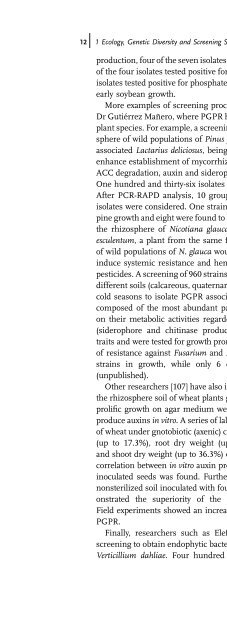Page 2 Plant-Bacteria Interactions Edited by Iqbal Ahmad, John ...
Page 2 Plant-Bacteria Interactions Edited by Iqbal Ahmad, John ...
Page 2 Plant-Bacteria Interactions Edited by Iqbal Ahmad, John ...
You also want an ePaper? Increase the reach of your titles
YUMPU automatically turns print PDFs into web optimized ePapers that Google loves.
12j 1 Ecology, Genetic Diversity and Screening Strategies<br />
production, four of the seven isolates were positive for siderophore production, three<br />
of the four isolates tested positive for b-1,3-glucanase production and two of the five<br />
isolates tested positive for phosphate solubilization, increasing at least one aspect of<br />
early soybean growth.<br />
More examples of screening processes are those performed in the laboratory of<br />
Dr Gutiérrez Mañero, where PGPR have been isolated from the rhizosphere of wild<br />
plant species. For example, a screening for PGPR was performed in the mycorrhizosphere<br />
of wild populations of Pinus pinea and P. pinaster and in the mycosphere of<br />
associated Lactarius deliciosus, being the targeted microorganisms that are able to<br />
enhance establishment of mycorrhization. Of the 720 isolates, 50% were tested for<br />
ACC degradation, auxin and siderophore production and phosphate solubilization.<br />
One hundred and thirty-six isolates showed at least one of the evaluated activities.<br />
After PCR-RAPD analysis, 10 groups were formed with 85% similarity when all<br />
isolates were considered. One strain of each group was tested to see if it improved<br />
pine growth and eight were found to be effective. PGPR have also been isolated from<br />
the rhizosphere of Nicotiana glauca to improve the performance of Lycopersicon<br />
esculentum, a plant from the same family. The rationale was that the rhizosphere<br />
of wild populations of N. glauca would be a good source for putative PGPR able to<br />
induce systemic resistance and hence to be used in reducing chemical inputs of<br />
pesticides. A screening of 960 strains in the rhizosphere of Nicotiana, grown in three<br />
different soils (calcareous, quaternary and volcanic), was performed in both hot and<br />
cold seasons to isolate PGPR associated with this genus. A subset of 442 isolates<br />
composed of the most abundant parataxonomic groups was characterized based<br />
on their metabolic activities regarded as putative PGPR traits related to defense<br />
(siderophore and chitinase production). Fifty percent tested positive for both<br />
traits and were tested for growth promotion of L. esculentum seedlings and induction<br />
of resistance against Fusarium and Xanthomonas. The results were positive for 30<br />
strains in growth, while only 6 enhanced resistance against foliar pathogen<br />
(unpublished).<br />
Other researchers [107] have also isolated a large number of PGPR bacteria. From<br />
the rhizosphere soil of wheat plants grown at different sites, 30 isolates that showed<br />
prolific growth on agar medium were selected and evaluated for their potential to<br />
produce auxins in vitro. A series of laboratory experiments conducted in two cultivars<br />
of wheat under gnotobiotic (axenic) conditions exhibited increases in root elongation<br />
(up to 17.3%), root dry weight (up to 13.5%), shoot elongation (up to 37.7%)<br />
and shoot dry weight (up to 36.3%) of inoculated wheat seedlings. A positive linear<br />
correlation between in vitro auxin production and increase in growth parameters of<br />
inoculated seeds was found. Furthermore, auxin biosynthesis in sterilized versus<br />
nonsterilized soil inoculated with four selected PGPR was also monitored and demonstrated<br />
the superiority of the selected PGPR over indigenous microflora.<br />
Field experiments showed an increase of up to 27.5% over the control using these<br />
PGPR.<br />
Finally, researchers such as Eleftherios et al. [108] have performed a direct<br />
screening to obtain endophytic bacteria able to protect against the pathogenic fungi<br />
Verticillium dahliae. Four hundred and thirty-eight bacteria were isolated from
















